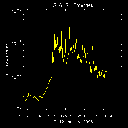 |
 |
Science Nugget: Jan 17, 1998
(Click on an image to see a larger, more visible, version.)
 |
 |
This GOES light curve (left) shows that the initial period of Active Region (AR) growth (starting at about 18:00 UT on Jan. 10) did not seem to result in flares, but instead the brightening of more stable structures. We do not know if this pattern - steady loops at the beginning of flux emergence, followed by flaring - is typical, but we do know that solar active regions have steady as well as flaring loops. Does this warrant investigation?
No! It turns out (see panel on right) that these were two separate emergences in the same complex. One can easily see the earlier benign structures, still sitting there in the later image, with the new violent emergence in the E part of the complex. Thank goodness for SXT's nice images. The preceding area was pallid, the following one refulgent, apparently. That may still warrant investigation, but not so urgently, and we sadly say goodbye to this week's nugget for lack of time...
However as one last remark, the sunspot area on 12-Jan (even after the flares commenced) was still only 20 millionths. The flares, once they began to happen, look striking in the GOES plot shown, but also had an interesting distribution. During the week there were 21 C-class events listed, as opposed to a single (marginal) M event. This is not the "correct" distribution of flare luminosities and favors microflares. This conclusion is perhaps not statistically significant, but it's suggestive that this distribution (e.g. Hudson, 1978) is not universal. In fact many of the events in 8131 were microflares of the type studied by Shimizu et al. (1992).
These nuggets have been produced since Fall 1997. See the index if you're interested in others of these quick looks.